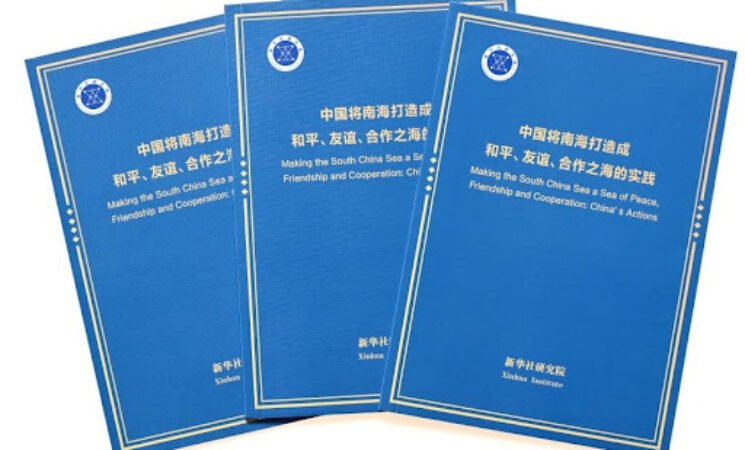11 June 2025, NIICE Commentary 11246
Dr Chander Shekhar
To make the South China Sea a sea of peace, friendship and cooperation, collective efforts are required by addressing common concerns, doubts and threats faced by stakeholders in the region, and not replicate what the Europe is undergoing through to shape regional security architecture with regional characteristics and avoid miscalculation over the disputed territory, argued by Dr. Chander Shekhar.
In the midst of the war on the European continent, pundits are forecasting its spillover effects on other regions that have been stuck in managing disputes. None other than, which could make a big newspaper headline, is the South China Sea conflict that involves several countries in Asia’s Southeast Asian region. A dispute, which is unsettled, could be more dangerous if fought among several disputing parties. Learning lessons from such war one of the major parties to the dispute that claims over nighty percent of features in the South China Sea is the People’s Republic of China (PRC) that has focused on the South China Sea peace to avoid future confrontations with its neighbours, also resolved several boundary disputes with them in the past.
In this direction, the Xinhua Institute has released a latest short report on the South China Sea by underlining China’s position, building trust and confidence among parties and others in the region that it is committed to building this sub-ocean as “ocean of peace, friendship and cooperation”. Released on 8 June 2025, the title of this document is “Making the South China Sea a Sea of Peace, Friendship and Cooperation: China’s Actions”. It underlines the positive, ideal, and hopeful future of the South China Sea dispute; however, critics would point out its lack of empiricism and time. When it is tested with current advancements between China and the Philippines, one of the disputed parties, in the South China Sea.
Key Highlights
To begin with, the South China Sea is a territorial dispute over several features among Brunei, China, Malaysia, the Philippines, and Vietnam. Their overlapping claims vary from each other and are strengthened by their historical, geographical, cultural, and other records. During the Cold War period, several skirmishes were seen in the Spratly and the Paracel islands. The globalization and economic reforms revolution had pushed countries to divert energy from conflict to cooperation and peaceful transformation. To shelve conflict over the South China Sea, actors both China and the Association of Southeast Asian Nations (ASEAN) in the interest of region and welfare of people developed series of norms, like peaceful resolution of conflict, creating a friendly atmosphere in the South China Sea, etc in the collective efforts of Declaration of the Conduct in the South China Sea (DOC) in 2002. Over the last more than two decades, many ups and downs have been recorded, yet parties did not choose even sub-conventional war to regain claimed historical territory.
The Xinhua report recounted that China has adhered to the principles of “equal-footed consultation, rules-based co-management, mutually-beneficial cooperation and a constructive role” for a new era of partnership for building and representing, among others like India, the voice of the global south in real terms. The report also advocated that “China has always been a steadfast advocate, promoter, and guardian of peace and stability in the South China Sea”, the harmony and equation largely depend on the collaborative efforts between the ASEAN and China, through building trust and deepened cooperation in economic, political and cultural domains the partnership has created a long-term mutual benefit. The tone of the report appears a compromising one for win-win benefits, given up zero-sum attitudes, respectful for neighbours and carries fruits of hope, and does not reveal facts, which if applied would suggest a distinct proposition. Likewise, it could also end up as a short-term vision if a legally binding regime is not finalized, which is, though, under consultation.
Rising Tension between the Philippines and China in the Troubled Water
Among others, the Philippines-China case is significant to underline as it is most visible and highlighted by analysts. Several standoffs were noticed between the coast guards of the two countries. In April 2025, both were found asserting sovereignty and clash over Sandy Cay in the South China Sea. They were playing the game of mutual accusation to serve their interests. In similar patterns, they engage in confrontation over other features, namely, Scarborough Shoal, Second Thomas Shoal, Sabina Shoal, and Whitsun Reef.
From these cases, the Xinhua report over disputed water lacks facts, but sets a presupposed map of navigating troubled water to make it calm through a win-win cooperation approach, which needs to be strengthened, not become a weapon to subjugate the other party. Recently, on 08 June 2025, a Chinese ship ran aground in the shallow waters off a Philippines-occupied island in the disputed South China Sea, which pushed Manila forces to go on alert. These trends, in contrast to the above report, present challenges to the South China Sea order.
Conclusion
The Xinhua Institute report presents major highlights of what the PRC at the onset has been repeating to make the South China Sea a zone of peace, friendship, and cooperation. These objectives can not be achieved unless there is a consistent tone in practice, as several episodes of minor clashes and standoffs were seen between the conflicting parties. It is also clear that China is pretty aware of and therefore has clear doubts about arousing writing, making it a zone of conflict. A long-term approach requires China to focus on the concerns of other parties and create grounds for peaceful negotiation and collective efforts.
South China Sea is not concerned merely with local actors, but explicitly involve extra-regional, and international actors as it is and has been for international economies a gateway of prosperity and growth for centuries. So consistent peace is pre-requisite to shared prosperity than two faced approaches with regard to the South China Sea.
Dr Chander Shekhar is a Researcher and Author at the Centre for International Politics, Organizations and Disarmament, Jawaharlal Nehru University, New Delhi, India

